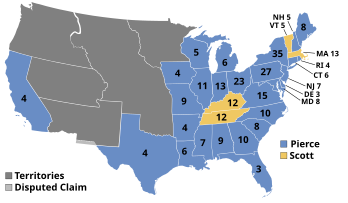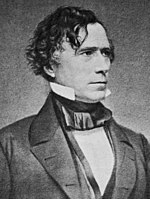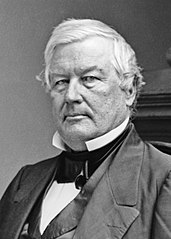1852 United States presidential election
Millard Fillmore Whig Franklin Pierce Democratic Presidential elections were held in the United States on November 2, 1852.Scott strained Whig Party unity as his anti-slavery reputation gravely damaged his campaign in the South.Pierce and running mate William R. King won a comfortable popular majority, carrying 27 of the 31 states.[2][3] The delegation from Maine proposed that the vice-presidential nomination should be given to somebody from the Southern United States with William R. King being specifically named.William H. Seward, who had been the main opponent of the compromise in the United States Senate and advised President Zachary Taylor against it, supported Scott.[2][4] Nine southern Whig members of Congress, including Alexander H. Stephens and Robert Toombs, refused to support Scott.Alabama held a state convention from July 13–15 and discussed at length the options of running a separate ticket or supporting Pierce and King.The committee took its time reviewing the positions of Pierce and Scott, finally deciding on August 25 to call a convention for a Southern Rights Party ticket.Troup stated in a letter, dated September 27 and printed in the New York Times on October 16, that he had planned to vote for Pierce/King and had always wholeheartedly supported William R.D.The Party's executive committee edited the letter to excise those portions which indicated that Troup preferred to decline, a fact which was revealed after the election.Nonetheless, some of those who rejected the fusion strategy held a Liberty Party National Convention in Buffalo, New York.A second convention was held in Syracuse, New York, in early September 1852, but it too failed to draw enough delegates to select nominees.[9] Just nine days before the election, Webster died, causing many Union state parties to remove their slates of electors.[10] When American voters went to the polls, Pierce won the electoral college in a landslide; Scott won only the states of Kentucky, Tennessee, Massachusetts, and Vermont, while the Free Soil vote collapsed to less than half of what Martin Van Buren had earned in the previous election, with the party taking no states.The fact that Daniel Webster received a substantial share of the vote in Georgia and Massachusetts, even though he was dead, shows how disenchanted voters were with the two main candidates.A shift of 69,000 votes to Scott in Delaware, Maryland, New York, North Carolina, Ohio and Pennsylvania would have left the electoral college in a 148–148 tie, forcing a contingent election in the House of Representatives.The Southern Rights Party effectively collapsed following the election, attaining only five percent of the vote in Alabama, and a few hundred in its nominee's home state of Georgia.Source: Data from Walter Dean Burnham, Presidential ballots, 1836–1892 (Johns Hopkins University Press, 1955) pp 247–57.









1852 United States electionsElectoral CollegeFranklin PierceWinfield ScottDemocraticNew HampshireNew JerseyWilliam R. KingWilliam A. Grahamelectoral votesMillard FillmorePresidential electionsUnited StatesZachary TaylorCompromise of 1850Fugitive Slave Law1852 Whig National Convention1852 Democratic National Conventiondark horseFree Soil Partythird partyterritoriesJohn P. HaleMexican–American Warhighest share of the electoral voteJames Monroe1820 re-electionRepublican PartyU.S. senatorAlabamaLewis CassMichiganJames BuchananU.S. secretary of statePennsylvaniaWilliam L. MarcyU.S. secretary of warNew YorkStephen A. DouglasIllinoisnational conventionBenjamin F. HallettDemocratic National CommitteeCommanding General of the U.S. ArmyU.S. Secretary of the NavyU.S. Armypresident of the United StatesMassachusettsDaniel WebsterWilliam H. SewardUnited States SenateWilliam Alexander GrahamAlexander H. StephensRobert ToombsBarnburnersConscience WhigsPittsburgh, PennsylvaniaGeorge W. JulianSamuel LewisJoshua R. GiddingsUnion PartyAlexander StephensGeorge CurtisCharles J. JenkinsFaneuil HallBostonKnow-Nothing partycerebral hemorrhagenativistsCatholicismKnow NothingsGeorge C. WashingtonGeorge WashingtonJacob BroomReynell CoatesGeorge TroupGeorgiaJohn QuitmanLiberty PartyBuffalo, New YorkGerrit SmithCharles DurkeeSyracuse, New YorkWilliam GoodellHenry Claybrigadier generalJames K. PolkKentuckyTennesseeVermontMartin Van BurenKnow-Nothing1854 electionsKansas–Nebraska ActNorth CarolinaFree SoilGeorge Washington JulianIndianaNative AmericanSouthern RightsJohn A. QuitmanMississippiNational Archives and Records AdministrationUniversity of North Carolina at Chapel HillWalter Dean BurnhamPierceGrahamArkansasCaliforniaConnecticutDelawareFloridaLouisianaMarylandMissouriRhode IslandSouth CarolinaVirginiaWisconsinHistory of the United States (1849–65)Inauguration of Franklin PierceSecond Party System1852–53 United States House of Representatives elections1852–53 United States Senate electionsNative American PartyGrover Cleveland